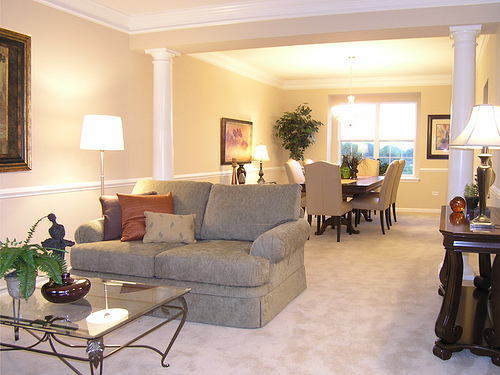Showtime for Home Sellers: Make Your House Shine with Staging

© 2012 by Aurelio Locsin.
If you need to sell your home in today’s tough housing market, you need to distinguish it from the dozen others nearby that are also on the market. Staging can make your house look bigger and better through some carefully chosen decorations, upgrades and repairs. You can spend thousands of dollars hiring professional stagers. Or you can follow these tips to stage your home at little-to-no cost.
Visit a model home.
If you don’t keep up with decorating trends, you may not realize that brass fixtures and pink carpet are no longer in vogue. A fun way to educate yourself is to visit model homes. Make note of the colors of the walls and carpets, the patterns in the window coverings and bed sheets, the size and style of furniture, and how rooms are arranged. The closer that you can get to duplicating these effects in your own home, then the more modern and appealing your offering will become.
Remove all unnecessary furniture.
One of the main reasons that people buy a house is because their old abodes no longer lack the space for their growing families. You can make your rooms look bigger by removing most of the furniture. For example, a bedroom crammed with a bed, dresser, two nightstands, armoire, desk and office chair looks cramped. Leaving only a bed and the nightstand opens up the area.
If you cannot comfortably walk through a room or around its major pieces, then it contains too much furniture. But do not leave room empty. They will look smaller and buyers need some furniture to know what a room is for. If you don’t have a friend or relative who can store the goods that you remove, rent space in a storage facility to temporarily keep your extra stuff.
Declutter and organize.
Your kids’ toys on the floor, the papers scattered on your desk and the Christmas decor stuffed in your closets tell potential buyers that your home does not have enough storage. Take all these extra items and keep them in your rented space. You want your built-in shelves, kitchen cabinets and bedroom closets to look almost empty. Then organize the remaining items neatly so they have enough breathing room around them.
Remove the “you” from your house.
You want potential buyers to imagine themselves living in your house. They can’t do that if you keeping popping up in the form of personal pictures, collections and hobby decorations. Remove your family photos, sports trophies, Elvis plate collections or anything else that is personal. Stick to neutral artwork and plants to decorate your rooms.
Clean behind the obvious.
Buyers want to see the surface and not the dirt, so be sure to clean the tops of doorframes, inside the fridge or behind bookshelves. Buyers like to run their fingers in these inaccessible spaces just to see what kind of housekeeper you are. Wash all windows and screens so the sunlight shines in and brightens all the spaces.
Paint to neutralize.
If your room is painted in bizarre or dark colors, or contains dated wallpaper, the cheapest way to spruce it up is to paint it. Remove the wallpaper first and patch up any halls or cracks. If the underlying color is strong and dark, you may need to apply primer first, or the previous color will show through. Then use a light, neutral color to cover the walls. If you have time and money, using a contrasting color on window and door trim adds a decorator touch.
Fix all problems.
Repair any obvious problems such as leaky faucets, missing closet doors or non-working light switches. If you think you don’t have the money to make repairs, be prepared for buyers to ask for discounts on the sales price to cover any problems they have to fix up. They tend to overestimate the cost of repairs, so do as many of these fixes as you can beforehand.
Target your market.
If you don’t know who the target market is for your property, ask you realtor. Then decorate the rooms to appeal to that market. For example, your spare room might become a nursery for a young family, an office for a singles, a kid’s room for an established family or a guest room for a retired couple. Include spaces that are useful to your potential buyer, regardless of what you use them for. For example, an empty corner in your family room might become a study area for a family with school kids, while that same area turns into a bar for single professionals.








